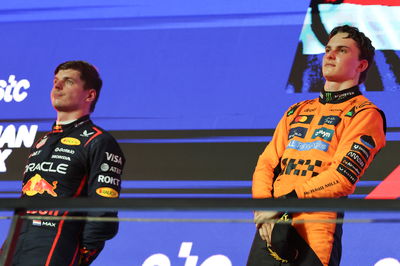Safety review to have multiple focus.
The tragic death of 52-year old marshal Graham Beveridge at the Australian Grand Prix last weekend is expected to provide many views on how racing safety can be improved further.
While there are calls for a calm and rational approach to what many are viewing purely as a freak accident, there will undoubtedly be a call for improved measures to protect marshals and spectators at events as well as drivers. The Australian tragedy occurred less than six months after a similar fatality at Monza last season, and has heightened awareness of an otherwise overlooked situation.
The tragic death of 52-year old marshal Graham Beveridge at the Australian Grand Prix last weekend is expected to provide many views on how racing safety can be improved further.
While there are calls for a calm and rational approach to what many are viewing purely as a freak accident, there will undoubtedly be a call for improved measures to protect marshals and spectators at events as well as drivers. The Australian tragedy occurred less than six months after a similar fatality at Monza last season, and has heightened awareness of an otherwise overlooked situation.
Although the wheel which killed Mr Beveridge is understood to have passed through a minuscule gap left in the catch fencing to allow marshals access to crash sites and stricken cars, focus will certainly fall on how the errant part managed to detach itself from the car despite the presence of extra, and strengthened, tethers designed to prevent such an occurrence.
Grand prix rules insist that all cars are fitted with two Kevlar tethers this season but, in both the fatal accident and that involving Luciano Burti on Saturday, wheels still separated from the moorings.
Although the FIA has defended its stance on the tethers, it has become apparent that the current system is not as effective as would be hoped. Whilst Kevlar has proved to be a very strong material in other situations, it has yet to prove that it can withstand forces acting across it, causing it to shear in accidents such as that between Ralf Schumacher and Jacques Villeneuve on the weekend.
Whilst outsiders are advocating a possible switch to steel, the FIA remains adamant that the current materials are as failsafe as can be expected.
"The tethers have a 5000kg breaking strain," explained technical delegate Peter Wright in an interview with Britain's Independent newspaper, "but you can generate forces greater than that - never mind any cutting action - and, under certain circumstances, [the tethers] are going to fail, and there's not much you can do about it.
"Using two tethers makes a lot of sense but, if you trap a wheel against a barrier or something, and then drag it, you are not going to stop the car tearing it off."
The review, and inquiry set up by Victorian state officials, will also look at the provision of safety fencing at Albert Park. Although the circuit utilises ten-foot high steel mesh constructions at all points, observers were quick to point out that parts from both the Williams and BAR in Sunday's accident flew well above this height, leaving marshals and spectators behind the fences exposed to debris.
Former world champion, team boss and fervent safety campaigner Jackie Stewart has called for a review of the fencing in Melbourne, advocating that higher and stronger solutions be used in future. Similar accidents in the US CART series - notably when a wheel from Adrian Fernandez' car flew into a crowd at an oval event - have seen the introduction of higher fences with curved top sections to deflect debris back trackside rather than allowing it access to spectator enclosures.
Formula One's newest team boss, and ex-pat Australian, Paul Stoddart has defended Albert Park's reputation, claiming that it remains one of the safest venues anywhere in the world.
"It was a freak accident, and nothing could have prevented it," he told the Australian press, "When things are travelling as fast as Formula One cars and things go wrong, they go monumentally wrong - but it is motorsport that is dangerous [not the circuit]."
The other question mark surrounding Mr Beveridge's death lies with the speed with which he was treated, with observers saying that the medical teams arrived to late to make any real difference to his condition, and pointing out that the ambulance transferring him to hospital had to cede to the safety car and remaining competitors, instead of being granted priority passage out of the venue.
Short of removing marshals - and potentially spectators - from the equation, there is little that could conceivably have been done to prevent a 'one-in-a-billion' incident from claiming the life of a track worker on Sunday, but there are suggestions that this may be the next course of action.
Williams technical director Patrick Head stops short of calling for marshals to be replaced by mechanical devices, but insists that the volunteers be given better protection while they go about their jobs.
"I think marshals will have to have more robust protection around them," he told the Reuters news agency, "You've got to ask if the marshal [in Australia] had proper protection where he was standing because, if you have open-wheel racing cars, it does not matter what you do about tying bits to the car, there are always going to be bits flying around."
Cockpit light systems to replace the antiquated flagging of signals have been mooted as a possible step in the right direction towards protecting officials - but have yet to be fully implemented - while the FIA has also said it will press forward with a remote speed control system to police cars under yellow flag conditions.
Neither solution, however, can completely remove the need for human intervention in the event of an accident or stranded car.










